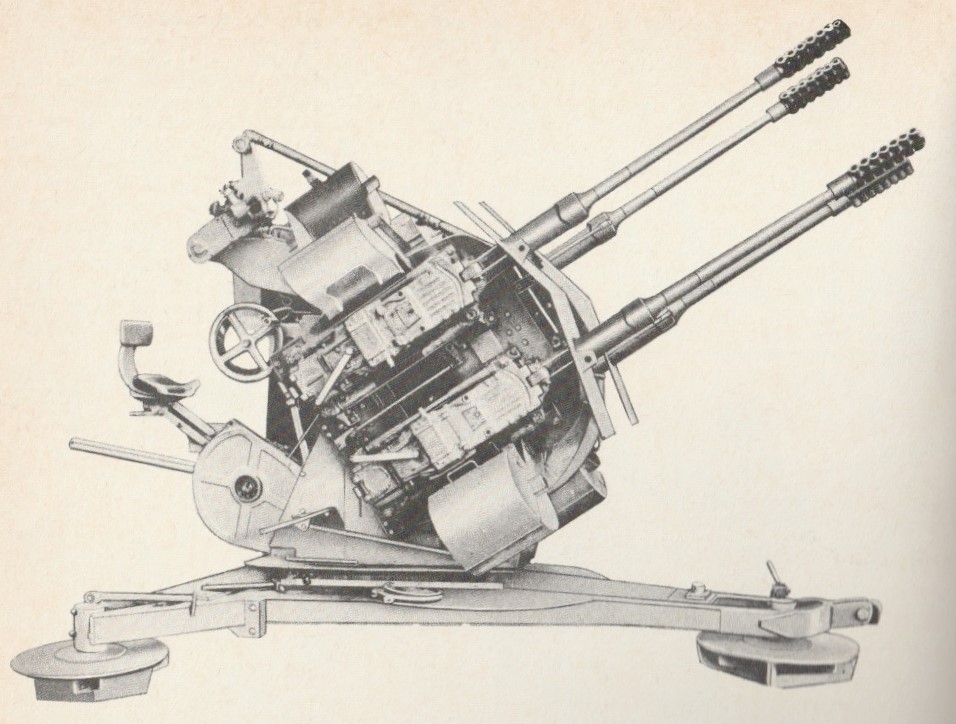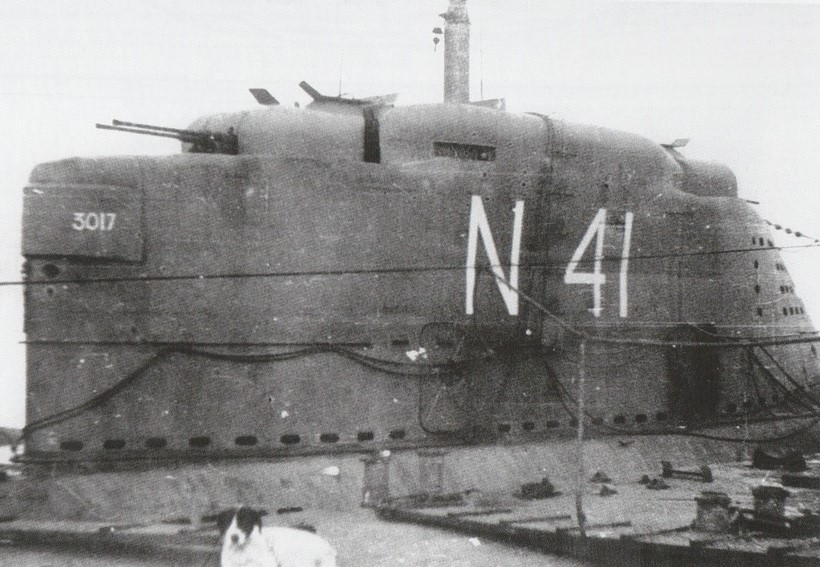A late-war modification of the Rheinmetall-Borsig 3 cm Maschinekanone 103 (MK 103) that was intended to arm the Type XXI U-boats as well as for Wehrmacht units. Single guns were to be used with the 2 cm Flak 38 mounting. This combination was not successful as the 2 cm Flak 38 mounting was not sturdy enough to handle the much greater recoil forces from the more powerful gun. The vibration made aiming difficult and also caused damage to the mounting. The gun was given a muzzle brake, the mountings were strengthened and a spring-suspended aiming sight was added to combat the vibration problems, but these did not completely resolve the issues.
It was intended that these guns were to be used in a twin "Flak Tower" on the Type XXI submarines, but the guns were not ready in time and the towers were instead armed with 2 cm AA guns.
This weapon fired with the breech locked at the moment of firing and was belt-fed. The belt was a disintegrating link type.
A Note on Sources: Some reference works state that the Type XXI U-boats were to use 3 cm MK 303 cannons. These seem to be based upon older, secondary sources. The more recent "German Naval Guns: 1939 - 1945" states that they were actually MK 103 cannons and shows several German design prints of the 3 cm guns intended for the Type XXI U-boats that are titled as MK 103 Pz. und Fl. See the adjacent example of one of these design prints. As the original Rheinmetall and Mauser turret design was handed over during the war to the Zbrojovka plant at Brno, Czechoslovakia, it possible that the MK 303 guns were substituted at some point. As the Czechoslovakia engineers never finished their turret design, it is somewhat speculative as to what were the actual gun types intended to be used for the Type XXI U-boats.
| Designation | 3 cm Flugabwehrkanone 103/38 |
|---|---|
| Ship Class Used On | Not in Service. Intended for the Type XXI U-boats, Type 42 destroyers and S-bootes |
| Date Of Design | 1943 |
| Date In Service | 1945 |
| Gun Weight | 1,366 lbs. (619 kg) |
| Gun Length oa | 91.25 in (2.318 m) |
| Barrel Length | 52.67 in (1.338 m) |
| Rifling Length | N/A |
| Grooves | (16) N/A |
| Lands | N/A) |
| Twist | Uniform RH 1/30 |
| Chamber Volume | N/A |
| Rate Of Fire | 400 rounds per minute cyclic
250 rounds per minute practical |
| Type | Fixed |
|---|---|
| Weight of Complete Round | HE-T: 1.80 lbs. (0.815 kg)
Others: N/A |
| Projectile Types and Weights 1 | AP-T: 1.10 lbs. (0.500 kg)
HE-T: 1.42 lbs. (0.644 kg) HE Minengeschoss-T: 0.73 lbs. (0.330 kg) |
| Bursting Charge 2 | HE-T: N/A
HE Minengeschoss-T: 0.22 lbs. (0.10 kg) RDX/TNT/Aluminum |
| Projectile Length | HE incendiary-T, complete round: 14.5 in (368 mm)
Others: N/A |
| Propellant Charge | About 0.07 lbs. (0.030 kg) |
| Cartridge Case Type, Size and Empty Weight | Brass, 30 x 184 mm, N/A |
| Muzzle Velocity | AP-T: 2,379 fps (725 mps)
HE-T: N/A HE Minengeschoss-T: 2,953 fps (900 mps) |
| Working Pressure | N/A |
| Approximate Barrel Life | N/A |
| Ammunition stowage per gun | Type XXI: about 900 rounds 3 |
- ^
Actual German designations AP-T 3 cm Pz Sprgr Patr El L'spur o Zerl HE-T 3 cm Sprg. Patr L'spur El o Zerl HE Minengeschoss-T 3 cm M-Gesch Patr L'spur El o Zerl The "El" designation meant that these cartridges were electrically fired. "Zerl" meant that they were self-destructing.
- ^Burster weight and type from German Artillery of World War Two.
- ^Each gun had 250 ready rounds stored in a pressure-tight compartment.
- The sources below differ in many areas for this weapon. The figures given in this table come mainly from "German Artillery of World War Two" and "Naval Weapons of World War Two."
| Elevation | Distance |
|---|---|
| Maximum Ground Range | 6,270 yards (5,730 m) |
| Max AA Ceiling | 15,420 feet (4,700 m) |
| Effective AA Ceiling | 4,920 feet (1,500 m) |
| Designation | Single Mount
Intended for Type 42C destroyers and S-bootes: Modified 2 cm Flak 38 Twin Mount
|
|---|---|
| Weight | N/A |
| Elevation | -10 / +90 degrees |
| Elevation Rate | N/A |
| Train | about -170 / +170 degrees |
| Train Rate | N/A |
| Gun recoil | N/A |
- ^Submarine turrets were hydraulically powered. The gunners used foot controls for gun firing and hand controls for gun elevation and turret turning. There was a scuttle in the top of the turret through which the gunner's head protruded. The forward face of the scuttle was protected by a shield which was interlocked with the guns and rose as the guns were elevated. The turret was carried on a ball bearing race. Turrets could be locked on the centerline with the guns locked at a -5 degree angle. The turret was very simple mechanically, and is understood to have been satisfactory except that the amount of hydraulic piping was excessive, the hydraulic operating units were exposed to sea pressure and that flexible oil piping was required. The result was that the hydraulic turret gear was the major source of salt water contamination of the hydraulic system. Unfortunately, this hydraulic system was also used to operate the periscope hoist, bow and stern planes, rudder, torpedo tube muzzle doors and the bow plane rigging mechanism as well as the gun turret motors. This meant that the salt water contamination would also affect these other units.
"Naval Weapons of World War Two" by John Campbell
"German Artillery of World War Two" by Ian Hogg
"German Naval Guns: 1939 - 1945" by Miroslaw Skwiot
"German Destroyers of World War Two (2nd Edition)" by M.J. Whitley
---
"Former German Submarine Type XXI: Report 2G-21", Portsmouth Naval Shipyard, Portsmouth N.H. On-line at U-Boat Archive.
04 October 2024 - New Datapage



